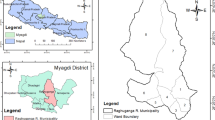Abstract
A field study was conducted to assess variations in physico-chemical characteristics of water of the springs located within the boundary of a Central Himalayan town where the springwater is used for drinking purposes. Monitoring of 12 springs was carried out for three seasons (winter, summer and monsoon). The results indicate direct influence of unplanned sewage disposal on the springwater quality as reflected by significant regional variations in the concentration of nitrates, chlorides, sulfates, sulfides and electrical conductivity. Population density varies within the town from 3110 to 14 137 persons/km–2 and has direct relationship with water quality. Springs located in the densely populated area had higher concentrations of all these compounds. Concentrations of nitrates up to 60 ppm were observed in some springs, making water unsuitable for human consumption. No significant changes were observed in springwater quality during different seasons.
Similar content being viewed by others
Explore related subjects
Discover the latest articles and news from researchers in related subjects, suggested using machine learning.Author information
Authors and Affiliations
Additional information
Received: 3 February 1995 · Accepted: 27 February 1996
Rights and permissions
About this article
Cite this article
Kumar, K., Rawat, D. & Joshi, R. Chemistry of springwater in Almora, Central Himalaya, India. Environmental Geology 31, 150–156 (1997). https://doi.org/10.1007/s002540050174
Issue Date:
DOI: https://doi.org/10.1007/s002540050174




